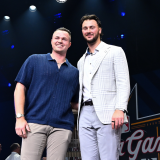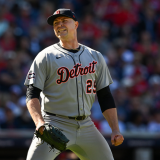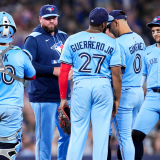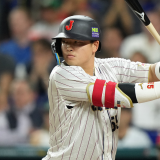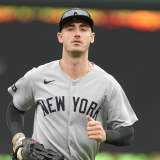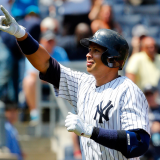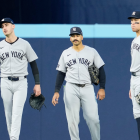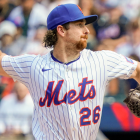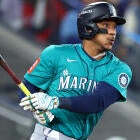The demise of the 'workhorse' starting pitcher and the rise of the super bullpen
Starting pitcher workloads are on the decline for a number of reasons

We should always be wary of attributing the start of something to a single moment, but this during Game 7 of last year's World Series felt a bit like a shifting of the dunes ...
Obviously, we'd seen Indians manager Terry Francona play it aggressively with his relief ace, Andrew Miller. It's one thing for Miller to come in early in relief of Trevor Bauer or Ryan Merritt or even a short-rested Corey Kluber in that same Game 7. In this instance, though, Cubs manager Joe Maddon was lifting a fully rested Kyle Hendricks after just 63 pitches and 19 batters faced and having allowed only one run. As you can also see, Hendricks was staked to a four-run lead at the time, and Maddon lifted him for a pitcher -- Jon Lester -- who hadn't made a relief appearance since 2007. Hendricks, it should be noted, finished third in the NL Cy Young balloting in 2016. Maddon's unconventionality and aggressiveness are certainly understandable given that we're talking about a winner-take-all affair. It was a jarring decision, though, and it hinted at something deep in the currents of baseball right now.
Take a look at this chart, which shows the league's average innings per start since 2000 ...

As you can see, it's on the wane, even compared to the high-offense era of the early aughts. The raw differences are huge -- we're talking about fractions of innings here -- but the trendline is undeniable. Starting pitchers aren't struggling in terms of run prevention -- their performance compared to relievers is right in line with recent history. Rather, it's about preemption on the part of managers.
What we saw going on in the postseason with Andrew Miller, Aroldis Chapman, and Kenley Jansen wasn't just about the excellence of those three relievers or their surprising adaptability. It was also about the undeniable reality that almost every starting pitcher experiences a decline in performance the more times he goes through an opposing lineup. It's called the "times through the order penalty," and teams, more analytically driven than ever, are paying attention more than ever. Whether because of fatigue or opposing hitters' getting familiar with his repertoire (or both, more likely), a starting pitcher gets significantly worse after he makes it through the opposing lineup for the first time.
As with anything else, there are outliers. Some pitchers have deep enough repertoires to keep hitters off balance even after repeated exposure, and some make a point to leave something in the tank for the late innings (this was a hallmark of Justin Verlander during his prime). The vast majority, though, see a big degradation in performance. For instance, Clayton Kershaw -- the acknowledged best pitcher in baseball -- certainly isn't immune. The first time he faces an opposing lineup, he allows an OPS of .519 with a K/BB ratio of 4.62. The second time through the lineup, he allows an OPS of .594 and a K/BB ratio of 3.74. Those are still very good numbers -- it's Kershaw, after all -- but they're demonstrably worse.
The conclusion teams are coming to -- and the conclusion that Maddon came to in the sequence above -- is that the fire-breathing reliever, of which teams have many these days, is a better option than most starting pitchers once they reach a certain point. This was acutely on display in the 2016 postseason, as noted. The question, though, is whether it's possible to scale such an approach to the six-month slog of the regular season. On that point, consider Marlins president of baseball ops Michael Hill's comments in this piece by Clark Spencer of the Miami Herald, pursuant to the signing of Dan Straily (h/t: Dave Cameron of FanGraphs) ...
Straily would join Edinson Volquez, Wei-Yin Chen, Tom Koehler and Adam Conley in the team's projected starting rotation this coming season. But Marlins president of baseball operations Michael Hill said Jeff Locke, Jose Urena and Justin Nicolino would also compete for spots, and that one -- or even two -- could end up in the bullpen as long relievers.
"We have said throughout the offseason with our acquisitions, we were looking at ways to shorten the game," Hill said. "I think whomever the players are who aren't a part of that five-man rotation will still pitch valuable innings for us because they represent bridges to get us to the back end of our pen."
After the tragic death of Jose Fernandez, the Marlins are of course without a genuine ace -- the kind of guy who can defy on occasion that times-through-the-order penalty. So you're left with a flawed and, at first blush, lacking rotation, and the Marlins appear poised to paper over that weakness by shifting more of the load to the bullpen. Again, it remains to be seen how sustainable such an approach is over the course of 162 games, but don't be surprised if the Marlins in 2017 reach new depths when it comes to the starters' share of innings.
This reality is self-reinforcing to an extent. Realizing it's not wise to let anyone but genuine frontline starters go deep, teams are more willing to carry eight relievers/13-man pitching staffs than they've ever been. That, in turn, diminishes the bench, which means not as many platoon-advantaged bats to counter those middle inning hard sliders and fastballs out of the pen. (Joe Sheehan has been all over the slow death of the major-league bench in his excellent newsletter.)
To be sure, there's also a countervailing human element to be considered. Managers, especially those with traditional inclinations, are going to be loath to pull a Madison Bumgarner or a Max Scherzer or a David Price in a preemptive fashion after, say, 60 pitches and with no runs on the board. Well, let's take a look at said demise of said workhorse. Most fans, I'd say, think of the modern workhorse as a starter who can consistently get the ball to the eighth-inning guy -- i.e., a starter who can average at least 7.0 innings per start. On that point, here's the number of qualifiers to average at least 7.0 innings per start in each season since 2010 (when run-scoring levels experienced a drop that we're just now getting past) ...

Last season, only one qualifying pitcher, Chris Sale, averaged at least 7.0 innings per start. One. Kershaw likely would've made the cut, but he didn't reach the necessary number of innings. The last time we had only one starter reach this threshold was 2006. However, back in '06 teams were scoring 4.86 runs per game compared to 4.48 runs per game last season. That's a huge difference.
So all these tactical considerations are chipping away at that workhorse mindset. Again, would you have thought that the top-three Cy Young finisher would get pulled one out from qualifying for the win and with a four-run lead, even in a Game 7? Would you have thought that a team would in essence acknowledge that its rotation will be de-emphasized during the upcoming regular season?
I don't want to overstate things and thunder from the rooftops of the world that, say, Bumgarner is going to start being lifted after he faces 12 batters or so, but the trends are clear, explainable, and -- like it or not -- rational. Teams are going seek out advantages and efficiencies where they can find them, and minimizing the times-through-the-order penalty is something they can do to that end. The question at this point is to what extent it's possible during the regular season. Will we soon see some team roster nine relievers? Before there's a correction will the league's starters average less that 5.0 innings per trip to the bump? Those seem unlikely outcomes, but a lot of what's already happened seemed unlikely at one point.
If Major League Baseball wants to put a finger on the scale to stop this, then it'll probably take significant rule changes -- limiting the number of relievers on the 25-man, for instance. For now, though, starting pitchers are less valuable than they've ever been, and it's not because they're worse than they've ever been.


